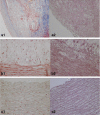Transauricular balloon angioplasty in rabbit thoracic aorta: a novel model of experimental restenosis
- PMID: 24529182
- PMCID: PMC3927627
- DOI: 10.1186/1476-511X-13-33
Transauricular balloon angioplasty in rabbit thoracic aorta: a novel model of experimental restenosis
Abstract
Background: The aim of this study was to demonstrate a percutaneous transauricular method of balloon angioplasty in high-cholesterol fed rabbits, as an innovative atherosclerosis model.
Methods: Twenty male New Zealand rabbits were randomly divided into two groups of ten animals, as follows: atherogenic diet plus balloon angioplasty (group A) and atherogenic diet alone (group B). Balloon angioplasty was performed in the descending thoracic aorta through percutaneous catheterization of the auricular artery. Eight additional animals fed regular diet were served as long term control. At the end of 9 week period, rabbits were euthanized and thoracic aortas were isolated for histological, immunohistochemical and biochemical analysis.
Results: Atherogenic diet induced severe hypercholesterolemia in both group A and B (2802 ± 188.59 and 4423 ± 493.39 mg/dl respectively) compared to the control animals (55.5 ± 11.82 mg/dl; P < 0.001). Group A atherosclerotic lesions appeared to be more advanced histologically (20% type IV and 80% type V) compared to group B lesions (50% type III and 50% type IV). Group A compared to group B atherosclerotic lesions demonstrated similar percentage of macrophages (79.5 ± 9.56% versus 84 ± 12.2%; P = 0.869), more smooth muscle cells (61 ± 14.10% versus 40.5 ± 17.07; P = 0.027), increased intima/media ratio (1.20 ± 0.50 versus 0.62 ± 0.13; P = 0.015) despite the similar degree of intimal hyperplasia (9768 ± 1826.79 μm² versus 12205 ± 8789.23 μm²; P = 0.796), and further significant lumen deterioration (23722 ± 4508.11 versus 41967 ± 20344.61 μm²; P = 0.05) and total vessel area reduction (42350 ± 5819.70 versus 73190 ± 38902.79 μm²; P = 0.022). Group A and B animals revealed similar nitrated protein percentage (P = NS), but significantly higher protein nitration compared to control group (P < 0.01; P < 0.01, respectively). No deaths or systemic complications were reported.
Conclusion: Transauricular balloon angioplasty constitutes a safe, minimally invasive and highly successful model of induced atherosclerosis in hyperlipidaemic rabbits.
Figures







References
-
- Bondjers G, Björnheden T. Experimental atherosclerosis induced by mechanical trauma in rats. Atherosclerosis. 1970;12:301–306. - PubMed
MeSH terms
LinkOut - more resources
Full Text Sources
Other Literature Sources
Medical
Miscellaneous

